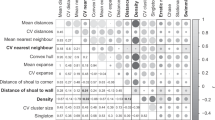Abstract
This protocol details a method for constructing and using both a holding tank and a test tank to assess the shoaling tendency of zebrafish and other teleosts. The test tank consists of a central compartment with two side compartments, one of which contains a shoal of stimulus fish. The focal fish is released and the amount of time spent associating with the stimulus shoal is recorded over a 10-min period. A holding tank enables individual fish to be accurately retested with a minimum of stress. Testing takes around 15 min per fish.


Similar content being viewed by others
References
Krause, J. & Ruxton, G. Living in Groups (Oxford, Oxford University Press, 2002).
Shaw, E. Schooling fishes. Am. Sci. 66, 166–175 (1978).
Pavlov, D.S. & Kasumyan, A.O. Patterns and mechanisms of schooling behavior in fish: a review. J. Ichthyol. 40, 163–231 (2000).
Wright, D., Ward, A.J.W., Croft, D.P. & Krause, J. Social organization, grouping, and domestication in fish. Zebrafish 3, 141–156 (2006).
Darland, T. & Dowling, J.E. Behavioral screening for cocaine sensitivity in mutagenized zebrafish. Proc. Natl. Acad. Sci. USA 98, 11691–11696 (2001).
Nadeau, J.H. & Frankel, W.N. The roads from phenotypic variation to gene discovery: mutagenesis versus QTLs. Nat. Genet. 25, 381–384 (2000).
Pitcher, T.J. Heuristic definitions of fish shoaling behaviour. Anim. Behav. 31, 611–612 (1983).
Wright, D., Nakamichi, R., Krause, J. & Butlin, R.K. QTL analysis of behavioural and morphological differentiation between wild and laboratory zebrafish (Danio rerio). Behav. Genet. 36, 271–284 (2006).
Wright, D., Rimmer, L.B., Pritchard, V.L., Krause, J. & Butlin, R.K. Inter and intra-Population variation in shoaling and boldness in the zebrafish (Danio rerio). Naturwissenschaften 90, 374–377 (2003).
McCann, L.I. & Matthews, J.J. The effects of lifelong isolation on species identification in zebrafish (Brachydanio rerio). Dev. Psychobiol. 7, 159–163 (1974).
Robison, B.D. & Rowland, W. A potential model system for studying the genetics of domestication: behavioral variation among wild and domesticated strains of zebrafish (Danio rerio). Can. J. Fish. Aquat. Sci. 62, 2046–2054 (2005).
Pitcher, T.J. & Parrish, J.K. Functions of shoaling behaviour in teleosts. In Behaviour of Teleost Fishes (ed. Pitcher TJ) 363–439 (London, Chapman & Hall, 1993).
Pritchard, V.L., Lawrence, J., Butlin, R.K. & Krause, J. Shoal choice in zebrafish (Danio rerio): the influence of shoal size and activity. Anim. Behav. 62 (2001).
Sokal, R.R. & Rohlf, F.J. Biometry 3rd edn.NewYork, WH Freeman and Company, 1995.
Author information
Authors and Affiliations
Corresponding author
Ethics declarations
Competing interests
The authors declare no competing financial interests.
Rights and permissions
About this article
Cite this article
Wright, D., Krause, J. Repeated measures of shoaling tendency in zebrafish (Danio rerio) and other small teleost fishes. Nat Protoc 1, 1828–1831 (2006). https://doi.org/10.1038/nprot.2006.287
Published:
Issue Date:
DOI: https://doi.org/10.1038/nprot.2006.287
- Springer Nature Limited
This article is cited by
-
Impairments of cerebellar structure and function in a zebrafish KO of neuropsychiatric risk gene znf536
Translational Psychiatry (2024)
-
Parallelized computational 3D video microscopy of freely moving organisms at multiple gigapixels per second
Nature Photonics (2023)
-
Shoaling guppies evade predation but have deadlier parasites
Nature Ecology & Evolution (2022)
-
Zebrafish knockout of Down syndrome gene, DYRK1A, shows social impairments relevant to autism
Molecular Autism (2017)
-
In-silico experiments of zebrafish behaviour: modeling swimming in three dimensions
Scientific Reports (2017)





